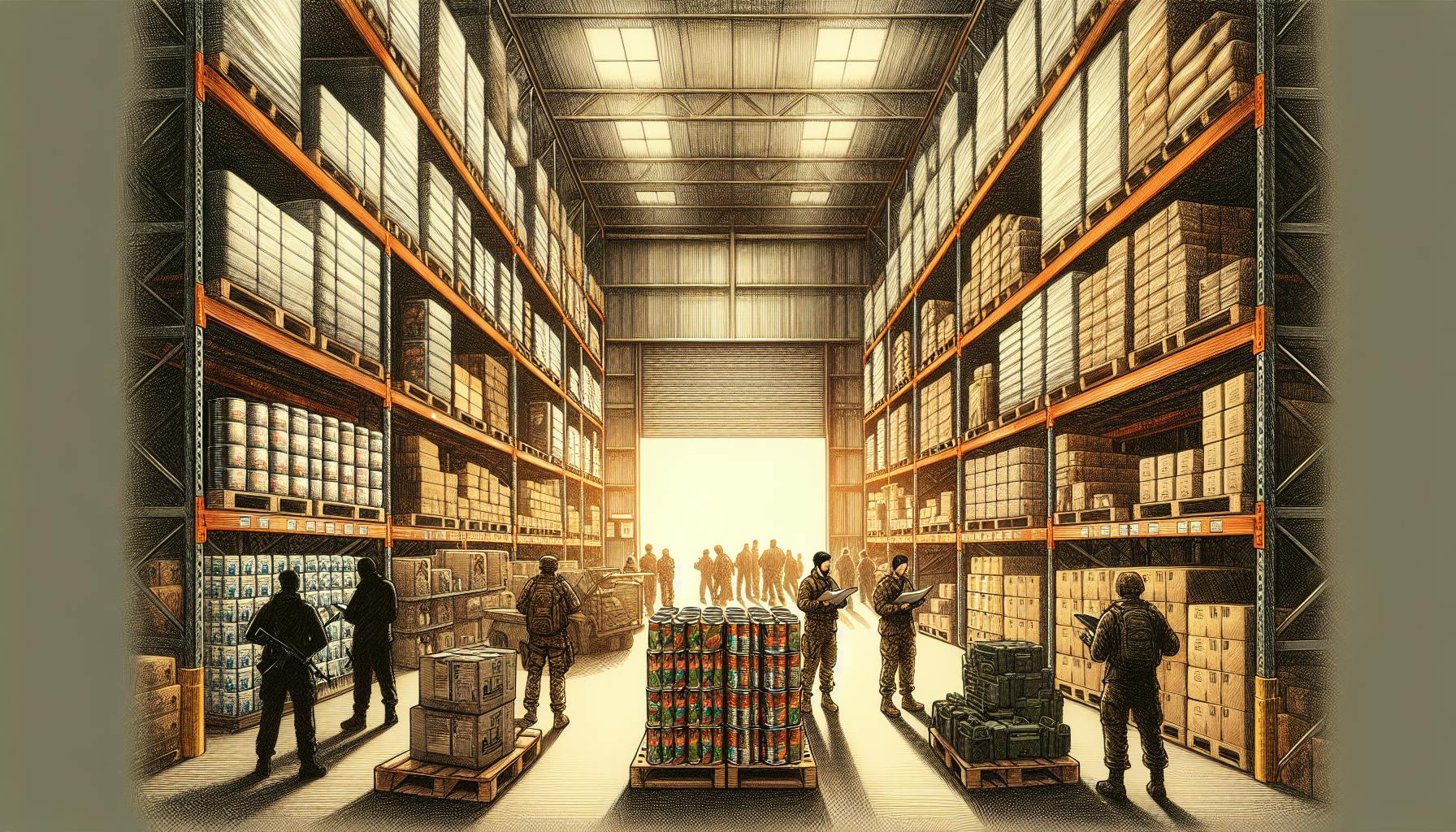Preparing for emergencies is wise, but gathering supplies can be overwhelming.
This comprehensive checklist makes assembling a 3-month emergency food supply straightforward, covering all necessary items to feed your household.
You'll learn the ideal duration, storage methods, and maintenance tips for an emergency cache, ensuring your family stays nourished if disaster strikes.
Introduction to 3 Month Emergency Food Supply
A 3 month emergency food supply refers to having enough non-perishable food and water stockpiled to feed yourself and your family for 90 days if normal access to food is disrupted. This section covers the basics of putting together your own emergency food supply.
Defining a 3 Month Emergency Food Supply
A 3 month emergency food supply is a stockpile of non-perishable food and water that can fully sustain you and your family for 90 days. This ensures you have reliable access to sufficient nutrition if an emergency situation occurs disrupting normal food supply chains. Such situations could include natural disasters, power grid failures, economic crises, or civil unrest.
Having 90 days worth of food storage allows you to hunker down in your home during the initial critical phase of an emergency event. It buys you time while utilities, supply chains, and civil order hopefully get restored.
Benefits of Having an Emergency Food Supply
Maintaining a 3 month emergency food supply delivers several key benefits:
- Food security in disasters when stores are emptied or supply chains falter
- Avoid desperate scrambles for limited food resources
- Ability to shelter in place rather than rely on overwhelmed governmental rescue efforts
- Peace of mind knowing your family will be fed no matter what the situation
- Rotate and consume emergency food as part of regular diet to avoid waste
Calculating Your Emergency Food Needs
To assemble your own emergency food supply, you need to calculate the calories and nutrients required to sustain your household for 90 days. Consider factors such as:
- Number of people in household
- Ages, sizes, and individual calorie needs
- Any dietary restrictions (gluten free, vegetarian, etc.)
- Stockpile diversity - include multiple food types
Online emergency food supply calculators can help estimate amounts needed. Expect to stockpile items like: canned goods, freeze dried meals, protein bars, bottled water, powdered milk, cereals, trail mix, and vitamins.
Rotate stock by consuming emergency food as part of regular diet and replenishing items before expiry. This avoids waste while keeping your 3 month buffer intact.
How long should emergency food supply last?
To be fully prepared for an emergency, experts recommend having at least a 3-month supply of non-perishable food items. Here's a quick overview of why a 3-month food supply is recommended:
-
Most disasters and emergency situations last for a few days up to a couple weeks. However, some scenarios like pandemics, wars, or economic collapse can disrupt food supply chains for months. Having a 3-month supply ensures you have nourishing food for your family no matter how long the crisis persists.
-
It takes time to adjust to a disaster scenario. A 3-month food supply buys you time to create a more sustainable plan for acquiring food and other necessities in an extended emergency.
-
Storing a 3-month supply is a reasonable and achievable goal for most families. When stored properly, non-perishable foods can last for years, making it easy to build up an emergency reserve over time.
-
Having reserves frees up money to focus on other areas of emergency preparedness. You can divert funds to medical supplies, self-defense, communication tools, etc.
So in summary, while shorter 1-2 week food supplies are good, a 3-month supply is ideal for handling nearly any scenario while allowing time to adapt to changing conditions in an extended crisis. Take steps now to build up a 3-month reserve of emergency food for your family.
How many people does the 4Patriots 3 month supply feed?
The 4Patriots 3-Month Survival Food Kit provides emergency food designed to feed a family of 4 adults for 3 months. With 688 total servings and 135,440 calories, this kit aims to meet the nutritional needs of a typical family during a crisis situation where access to food may be limited.
Some key details on the food supply capacity:
- The servings are based on a daily calorie intake of 1,800 calories per adult. This would cover a family of 4 adults for 90 days.
- For smaller households, the supply could be stretched further. For example, for a family of 2 adults, it could last around 6 months at 1,800 calories per day.
- If needing to feed children as well, the kit could cover a family of 4 for less time. Their lower calorie needs would help extend the supply somewhat.
- With careful rationing and planning, this kit could potentially be made to last longer in an emergency. But the 90 day timeframe is what it's designed for.
So in summary - the 4Patriots food kit is intended to feed 4 adults for 3 months at typical nutritional intake levels. But the servings could be adjusted based on your specific household size and needs in a crisis. Proper planning is key to making the most of your emergency food supply.
What is the longest lasting emergency food?
Dry goods like rice, oats, pasta, and quinoa are all versatile non-perishable foods that can last a long time without refrigeration. These pantry staples are essential for a complete 3 month emergency food supply.
Key Benefits of Non-Perishable Dry Goods
- Long shelf life - Properly stored, most dry goods can last 1-2 years or longer
- Nutrient-dense - Whole grains, legumes, pasta provide carbs, protein, fiber
- Versatile - Can be used to make a variety of breakfast, lunch, dinner recipes
- Cost-effective - Inexpensive per serving compared to freeze dried meals
- Easy to cook - Just add water and heat - no refrigeration needed
When building your 3 month emergency food supply, make sure at least 50% is composed of non-perishable dry goods such as:
- Whole grains: rice, oats, quinoa, pasta, crackers
- Legumes: beans, lentils, chickpeas
- Pantry items: olive oil, coconut oil, nuts, dried fruit
- Spices and seasonings
Pro tip: Calculate each family member's daily caloric needs and shop accordingly. Having the right balance of carbs, protein, fat, and nutrients is key for health and satiety during an emergency.
With the proper storage techniques, you can rely on versatile dry goods as the base of your long term food reserves. Make sure to integrate them into your regular diet rotation as well to avoid waste!
How do I build my 30 day emergency food supply?
When building your 30 day emergency food supply, focus on compact, lightweight, non-perishable foods that provide nutrition and calories. Here are some tips:
-
Canned goods: Stock up on canned meats, fruits, vegetables, soups, and beans. Choose low-sodium options when possible.
-
Grains: Include rice, pasta, oats, etc. Opt for whole grains when you can.
-
Protein: Beef jerky, canned tuna and chicken, peanut butter, and protein bars are great options.
-
Fruits and vegetables: Canned and dried fruits and veggies are essential for nutrients.
-
Dairy: Powdered milk, shelf-stable milk boxes, and powdered protein shakes provide calcium.
-
Snacks: Trail mixes, granola bars, nuts, and crackers satisfy cravings.
-
Drinks: Bottled water, juice boxes, and electrolyte mixes like sports drinks and drink powders.
-
Vital extras: Don't forget a manual can opener, utensils, paper plates, etc. Also pack a basic first aid kit.
When building your 30-day supply, think about each food group and what your family needs to stay nourished. Having compact, non-perishable items makes rotating and restocking simpler too. Start with a week's worth and build up over time.
sbb-itb-b932644
Best 3 Month Emergency Food Supply Essentials
This section provides a checklist of the best food essentials you'll want to stockpile for a complete 3 month emergency food supply.
Non-Perishable Staple Foods
When building your 3-month emergency food supply, prioritize non-perishable, high-calorie staple foods that will provide sustenance during a crisis. Here are some must-have items:
- Rice: White, brown, jasmine, basmati - rice is versatile, non-perishable, and calorie-dense. Aim for at least 20 pounds per person.
- Pasta: Dried pastas like spaghetti, penne, elbows, have a shelf life of 1-2 years. Stock up on your family's favorites.
- Beans: Canned or dried beans are packed with protein. Choose versatile options like black, pinto, kidney.
- Oats: Steel-cut or old fashioned oats are nutrient-dense and non-perishable.
- Canned vegetables/fruits: Canned produce like carrots, green beans, corn, peaches, pears can last 2+ years. Choose low-sodium options.
- Canned soups/stews: Condensed soups, chunky stews, and chili provide calories and comfort.
- Peanut butter: High in protein and healthy fats. Stock several large jars.
- Nuts/trail mixes: Calorie-dense nuts and mixes provide protein and good fats. Prioritize longer shelf-life options like almonds and walnuts over pecans and pistachios.
When stockpiling, do the math and aim for at least 2,000 calories per person per day. Having approximately a 3-month supply of versatile staples ensures your family will stay nourished in an extended emergency situation.
Canned and Packaged Meats
Including canned and packaged meats in your emergency food supply adds essential protein and nutrients. Some smart choices:
- Canned tuna/chicken: Tuna and chicken are versatile proteins, with cans that can last 2-5 years unopened. Choose packs in water or oil rather than heavy sauces.
- Vienna sausages: These small canned sausages are calorie and protein-dense.
- Spam/canned ham: Salt-cured meats like Spam can keep for years and don't require refrigeration.
- Canned chili/beef stew: Look for ready-to-eat options that can be eaten cold if needed.
- Beef/turkey jerky: Dried meats make a tasty, protein-packed addition.
When stocking canned and packaged meats, prioritize "pop-top" and ready-to-eat options that don't require a can opener or cooking, as access to tools and stoves may be limited in an emergency.
Fats and Oils
Fats and oils are concentrated sources of calories and nutrients that should be part of your emergency food reserves. Some smart choices:
- Vegetable/olive oils: Choose large bottles for multi-purpose cooking and calories. Oils can keep 2-3 years sealed.
- Nuts: Stock up on sealed cans or pouches of almonds, walnuts, pecans, peanuts. Nuts offer protein and healthy fats.
- Nut butters: Peanut, almond, and other nut butters are calorie-dense.
- Seeds: Sunflower, pumpkin, flax, and chia seeds provide nutrients and calories.
- Coconut oil: Has a long shelf life and is useful for cooking as well as health/beauty needs.
Having fats and oils on hand provides backup calories and nutrients to keep your family nourished in an emergency when access to fresh foods is limited.
Dried and Canned Milk Products
Including non-perishable dairy products ensures you'll have access to bone-strengthening calcium and other key nutrients during a disaster. Smart choices include:
- Powdered milk: Reconstitutes when water is added. Allows long-term storage without refrigeration.
- Evaporated milk: Shelf-stable canned milk lasts unopened for 6-12 months.
- UHT shelf-stable milk: Boxes of ultra-high temperature processed milk keep unopened for 6-9 months without refrigeration.
- Powdered protein shakes/meal replacements: Items like Carnation Instant Breakfast offer calories, protein, vitamins and minerals.
Having at least a 3-month supply of non-perishable milk products guarantees your family, especially growing children, will get sufficient calcium and vitamin D when fresh dairy is inaccessible.
Dried Fruits and Vegetables
Stocking up on dried produce allows you to benefit from the concentrated micronutrients found in fruits and veggies, even when fresh isn't an option. Smart choices include:
- Raisins, cranberries, apricots: Dried fruits offer antioxidants, fiber, vitamins.
- Apples, pineapple, mango: Dried fruits make easy snacks.
- Carrots, potatoes, onions: Dried veggie flakes and dices can be reconstituted.
- Beans, peas: Dried legumes provide protein.
- Mushrooms: Dried mushrooms add savory flavor.
- Herbs/spices: Garlic, basil, oregano, salt, and black peppercorns can be stored long-term.
Having at least a few pounds each of various dried fruits and vegetables guarantees your emergency food supply will contain ample fiber, vitamins, minerals and variety for nutrition even when fresh options are scarce.
3-Month Emergency Food Supply List: Meal Prep & Cooking Gear
This section covers the non-food supplies you'll require to safely store, prepare and serve meals from your emergency stockpile. Having the proper gear and equipment will ensure you can access and make use of your emergency food supply when needed.
Water Storage Containers
You'll need ample water storage for drinking, cooking, cleaning etc. 5 gallon jugs are ideal for storing clean potable water. Make sure to stock at least 1 gallon of water per person per day for a 3 month supply. Rotate and refresh water every 6 months.
Fuel & Heat Sources for Cooking
Stock propane tanks, sterno cans, firewood etc. to cook food if the power goes out. A camp stove or grill can be used with propane or sterno as a cooking surface. Have a manual can opener and mess kits ready for off-grid meal prep.
Manual Can Opener
A non-electric opener ensures you can access canned goods when the power is out. Stock multiple manual openers as backup and keep one in your bug-out bag. Test different manual opener models to find the best option.
Mess Kits & Utensils
Store plates, cups, cutlery, pots etc. for serving meals without power or running water. Lightweight backpacking mess kits take up little space. Have paper plates/bowls, plastic cutlery etc. as disposable alternatives.
3-Month Food Supply for Family of 4: Storing Your Emergency Food
Proper storage of emergency food is crucial to ensure it remains fresh and safe to eat when needed. For a 3-month supply for a family of 4, you'll need adequate storage space and containers.
Choosing Suitable Containers
- Use food-grade plastic bins or Mylar bags to store bulk items like rice, beans, pasta, and oats. This protects against pests and moisture.
- Glass jars or vacuum-seal bags work for smaller quantities. Ensure a tight seal.
- Label everything clearly with the contents and date.
Temperature Control & Monitoring
- Store food in a cool, dark place like a basement or closet. Temperatures between 40°F and 70°F are ideal.
- Monitor temperatures with a thermometer. Fluctuations can affect shelf life.
Pest Control Measures
- Air tight containers prevent entry from pests. Inspect regularly for any signs of contamination.
- Oxygen absorbers remove oxygen where pests can grow.
- Sprinkle diatomaceous earth around storage areas. The sharp dust deters insects.
Properly storing a 3-month emergency food supply takes some work but ensures your family will have safe, nutritious meals when needed. Invest in quality storage containers, monitor conditions regularly, and take preventative measures against pests.
3-Month Food Supply for 2: Maintaining & Rotating Your Emergency Food
For smaller households, efficiently managing your stored emergency food is key to ensuring it remains fresh and viable when you need it most. Here are some tips:
Inspection & Expiration Tracking
- Check food containers and packaging every 2-3 months for signs of spoilage, damage from pests, or other issues that may compromise safety or shelf life.
- Keep a log of expiration or best-by dates for all items in your emergency supply. Calendar reminders can help remember when to check dates.
- Inspect FIFO rotation to ensure older food gets used first (see below).
First In, First Out Rotation
- Integrate emergency food items into regular grocery shopping and meal prep. Use up older existing emergency stock, and replace it with newly purchased supplies to maintain freshness.
- Label food storage containers with purchase dates for easy identification of older vs newer inventory.
- Stick to the rule of thumb: first in, first out.
Replenishing Consumed Goods
- Check emergency food inventory levels monthly.
- Create a shopping list to replace consumed emergency food items. Stock up during sales or in bulk to save money.
- Set reminders to order more before you run too low. An 80% stocked pantry is a good buffer.
Following these practical maintenance tips will ensure your 3-month emergency food supply stays fresh and ready for smaller households when an emergency strikes.
Emergency Food Supply for Family of 4: Key Takeaways on Planning
Having enough emergency food and water for an entire household is crucial for disaster preparedness. When calculating your 3-month emergency food supply, be sure to account for the needs of all family members.
Have Enough for Entire Household
- Estimate the total calories each person will need per day and multiply by 90 days. Add 10-20% more as a buffer.
- Include a variety of nutritious, non-perishable foods like grains, beans, canned goods, nuts, and dried fruit.
- Don't forget pet food if applicable.
Store Food Properly
- Store in a cool, dark place in airtight containers safe from pests. Consider oxygen absorbers.
- Check expiration dates and continually rotate stock by using and replacing food before it expires.
- Take inventory every 6 months and replace anything compromised.
Continually Maintain & Refresh
- Inspect containers periodically for signs of spoilage like bulging lids.
- Replace any reserves that were tapped into over time.
- Update food supplies to account for household changes over the years.
Being prepared with proper emergency rations takes continual diligence, but is essential for weathering unexpected events. Use these tips to maintain complete food reserves for your entire household.


